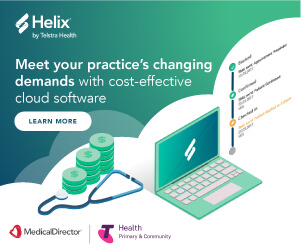ePrescribing: Your questions answered
The next phase of electronic prescribing is fast approaching, and practices are starting to prepare. We partnered with eRx Script Exchange, Australia’s electronic prescription gateway to answer your questions on electronic prescriptions, the Token Model, Active Script list, and more.
What is a Prescription Exchange Service (PES)?
In Australian a Prescription Exchange Service (PES) securely moves and stores prescription information electronically. A PES system is sometimes also referred to as open Prescription Delivery Service (PDS).
Are the PES Systems in Australia interoperable?
Yes, as of 2019 there are two PES providers in Australia which are interoperable with each other. This means that doctors and pharmacies can connect with either PES and patients are able to choose which pharmacy they visit to have their electronic prescription dispensed.
What is Electronic Transfer of Prescription (ETP)?
Electronic Transfer of Prescription (ETP) is the process by which the details of a legal prescription are transferred electronically from the doctor to the patient’s pharmacy of choice.
What is the difference between current ETP and electronic prescribing?
In the current ETP model, the legal prescription is the signed piece of paper from the doctor and the electronic transfer of data is purely an adjunct process to reduce transcription errors at the pharmacy. The new ePrescribing ETP also refers to the system of Electronic Transfer of Prescription information, however in this case the legal document is the data set residing in one of the PES systems.
When will electronic prescribing be legal in Australia?
The Federal laws were enacted to support electronic prescribing in November 2019. This includes changes to PBS rules which will facilitate payments to pharmacies for this new type of prescription. Beyond the Federal changes, each jurisdiction will need to adapt their local regulatory framework, including drugs and poisons regulations, to allow for electronic prescribing. These state and territory changes vary across the country and will happen over the coming months.
What will vendors of prescribing and dispensing systems need to do to enable their users to create and dispense electronic prescriptions?
To scope and define the changes required to bring electronic prescriptions to life the Australian Digital Health Agency (ADHA) have been working with a broad range of industry representatives in the form of a technical working group (TWG). This group has collaborated to define the architecture and conformance profile for the system and the Australian Digital Health Agency published these documents in September and October of 2019.
The Token Model
The token model for electronic prescribing is based on the legal prescription ceasing to be the signed physical paper prescription and instead becoming the relevant data set residing in one of the PES systems. In the token model, rather than generating and signing a prescription, the doctor provides a token to the patient for each item prescribed. The token provides a link to a unique code used by the dispensing pharmacy to access the legal document for dispensing.
In a similar way to the prescribing of an original prescription, once the pharmacies dispense electronic prescriptions, any tokens for repeats would be provided to the patient.
How do patients receive their electronic prescription token?
Patients can receive an image-based prescribing token via SMS, email or printed paper. Please note, token’s must not be printed on PBS script paper.
Can a patient have both a token and legal paper scripts for the same item?
No, a prescription can only be one or the other for the duration of its life, including any repeats.
Could the token model lead to channeling of prescriptions from doctors to specific pharmacies?
No, as the token will be in the possession of the patient, they will have the choice, as they do now with their paper prescription, on where to get their electronic prescription dispensed.
What are the benefits of the token model to the patient?
The token model means that the patient experiences less paper in processing a prescription and can more easily produce their token to a dispensing pharmacist. As an example, a sick person, having visited the doctor for treatment, could forward their SMS token to their spouse for them to fill at their pharmacy of choice. Equally, the patient may choose to forward their token to a pharmacy of their choice for dispensing and delivery – this could occur directly or via an intermediary app or service.
What are the benefits of the token model to the doctor?
Aside from the benefit of no longer having to print and sign paper prescriptions, the token model may enable doctors and other healthcare providers to provide better care to patients at a distance. As an example, a doctor could forward a prescription token to their patient following a telehealth consultation without the need for a follow up paper prescription (legal document). Doctors may also feel comfortable to re-issue tokens to patients in the event a token is lost as there is no risk of duplicating the legal document (which remains unchanged in the PES).
What are the limitations of the token model?
The token model has limited application for patients using multiple medicines. The electronic prescribing system does not solve the issue of patients losing their prescriptions.
Because tokens are provided on a “per item” basis with limited information over and above the token ID, multiple tokens may quickly become confusing and unmanageable. Patients with multiple tokens would need to click on the link for each token individually to bring up the token QR code and limited medicine safety information – a process that quickly becomes unwieldy with multiple prescriptions and repeats.
As a token must be presented when dispensing electronic prescriptions and is not able to be ‘searched’, patients are at risk of losing their tokens/prescriptions just as they are with a paper prescription. Whilst the legal document will remain in one of the PES systems, it is irretrievable without the unique token possessed by the patient.
What are some of the potential workflow impacts of the token model for doctors?
The token model does not necessitate the provision of a paper prescription to the patient, a practice which has become synonymous with the end of a consultation. Doctors may need to explain the new process to patients and provide reassurance that the token will be able to be dispensed at the patient’s pharmacy of choice.
Doctors will also need to consult with their clinical software vendor to ensure their system is able to create electronic prescriptions and has the functionality to provide tokens to their patients.
Will all types of community prescriptions be able to be ePrescriptions?
This will depend on jurisdictional regulators, but the intent from the Commonwealth has been to commence electronic prescribing on all types of prescriptions.
What happens when a pharmacy sends the doctor an owing prescription request?
The token model enables pharmacies to receive prescriptions from remote subjects of care without the need to physically obtain a paper prescription. This may reduce the burden of owing prescriptions and enable innovative models to be developed, such as enhanced delivery services, for the benefit of patients. Despite this likely decrease in owing prescription requests, where prescriptions are created to fulfil an owing request from a pharmacy (and these are created as paperless prescriptions), clinical systems will default to printing a paper token rather than conveying the token to the patient. This will enable the prescriber to forward this token directly to the requesting pharmacy in-line with jurisdictional regulations.
Will residential care facilities be able to direct chart prescriptions to their contracted pharmacy?
Yes, direct point to point transmission of charted prescription items for residents of care facilities is allowed for, but with some important caveats. Firstly, any point to point transmission of prescriptions for these patients must be done under equivalent safety, privacy and security standards to the PES providers. Secondly, facilities must provide patients with choice of pharmacy and must therefore be able to transmit prescriptions to the patient’s pharmacy of choice. Electronic chart solution vendors will also be able to submit ePrescriptions to a pharmacy via the eRx infrastructure.
Is there an expiry on the token?
The token will not be useable after the prescription’s expiry date.
The Active Script List (ASL) – an optional extension for the patient
How does the ASL work?
As with the token model, the ASL relies upon conformant ePrescribing messages instead of paper prescriptions. Building on the token model however, if a patient registers for the ASL they no longer require a token to access their prescriptions. The ASL enables patients to provide relevant pharmacies, doctors and third-party intermediaries of their choice with access to their personal list of active scripts ready for dispensing.
This access is revocable but may be otherwise ongoing or temporary depending on the access granted by the patient to each viewing party. It is important to note that this is only a list of their active scripts for future dispensing and not their full medication profile. Once access is granted, a pharmacy may dispense the items requested by the patient and doctors and third-party intermediaries can view the list.
How do patients register for the ASL at the doctor?
Patients will be able to go through an assisted registration process for the ASL at their doctor of choice. This process will involve an SMS (initiated through the prescribing software) from the doctor to the patient who must then consent to establish their ASL.
Once an ASL has been established for a patient, subsequent doctors or pharmacies may seek permission to access the ASL from the patient in a similar fashion via an SMS initiated by their prescribing or dispensing software.
Can a patient register for the ASL at the pharmacy?
Yes, patients will be able to go through an assisted registration process for the ASL at their pharmacy which involves an SMS (initiated through the dispensing software) to the patient who must then consent to establish their ASL.
How do patients allow a doctor or pharmacist to have access to their ASL?
Once an ASL has been established for a patient, subsequent pharmacies or doctors may seek permission to access the ASL from the patient by sending an SMS initiated by their dispensing or prescribing software to the patient. The patient will reply with Yes, No or One day only to allow access.
How do patients register for the ASL through their third-party intermediary app?
The ASL API will allow mobile vendors to facilitate patient registration to their ASL within their patient app as well as view, manage access and review access to their list. Part of the process of connection to the ASL API will be assurance about how each third-party intermediary identifies its users – it will be a requirement that this involves some face to face validation of identity either at the doctor or pharmacy.
Who will be able to access a patient’s ASL?
Patients are in control of who accesses their ASL and they may grant access to Australian doctors, pharmacies and third-party apps.
Importantly, the ASL does not provide access to the actual legal document (prescription) as this can only be access by doctors or pharmacies for the purpose of prescribing or dispensing.
Once a patient registers for an ASL, will all their electronic scripts be visible to permitted viewers?
Yes, once a patient has registered for an ASL, all the electronic prescriptions created, and all their subsequent repeats will show up in their ASL. If they are prescribed items that you do not wish to show in their ASL, they should ask their doctor for a traditional paper script. Alternatively, some third-party apps may provide patients with the ability to hide particular scripts in their ASL. If this is done, the script will be hidden from all doctors and pharmacies.
Will an ePrescription show in a patients ASL if the doctor’s software is not ASL-enabled?
Yes, despite the doctor not being able to view the patient’s ASL, the ePrescription will still flow through. In this case the token provided to the patient only remains relevant if the patient chooses to use it or could be discarded if the patient provides an ASL-enabled pharmacy access to their ASL.
If a doctor creates a traditional computer-generated prescription with a prescription exchange barcode on it, will this show in a patient’s ASL?
Yes, where a prescription is sent to a PES, even if it is paper prescription, it will be displayed in a patient’s ASL. It is however important to remember that patients would be required to present the signed prescription (the legal document) or one of its subsequent repeats (plus original duplicate) to the pharmacist in order to have it dispensed.
What if a handwritten or non-computer generated prescription with repeats is dispensed at a pharmacy with a PES connection – will the repeats show in a patient’s ASL?
No, any manually dispensed prescription that has subsequent repeat supplies will not be included in a patient’s ASL. This allows a patient to decide if paper prescriptions for sensitive items will appear in their ASL.
What happens when active scripts in an ASL expire?
Scripts which expire (e.g. at twelve months from the date of original prescription) will no longer be available for dispensing. They will however show for a period of 7 days post expiry as read-only within the patient’s ASL, before no longer appearing.
What happens when the last repeat of an active script in an ASL is dispensed – do they still show in the ASL?
Once the last repeat of a prescription in an ASL has been dispensed it will no longer appear in the ASL.
How can patients manage who has access to their ASL?
Yes, patients can manage who has access to their ASL with third-party intermediary apps.
Could the ASL lead to prescription channeling?
No, the patient can still choose where to have their medication dispensed. The ASL also enables the patient to control who has access to their ASL.
What are the benefits of the ASL to the patient?
The ASL has several benefits that build on those provided by the ePrescribing Token Model.
Patients managing their medicines with paper prescriptions today regularly visit multiple sites of care, leading to a fragmented picture of their prescriptions. Because the ASL provides approved healthcare professionals with a shared view of prescriptions available for dispense, clinical decision making should be more fact-based, leading to a reduction in prescribing and dispensing errors.
Another key benefit of the ASL is that because no tokens are required patients can no longer lose their prescriptions. This should lead to a reduction in Government costs from superfluous MBS claims for replacement tokens or paper scripts and a reduced risk in prescribing duplication.
Fundamentally the ASL further empowers the patient to choose where and how they have their prescriptions dispensed. A key example here is a patient on holidays being able to access a community pharmacy of their choice at their destination without having to get the paper document to that pharmacy.
What are the benefits of the ASL to the doctor?
Once a patient grants a doctor access to their ASL, they will be able to view the prescriptions which have yet to be dispensed for that patient. This provides more visibility over what other health professionals involved in the care of that patient are prescribing and dispensing, allowing for more informed clinical decision making. It may also reduce the number of superfluous administrative tasks by reducing unnecessary prescribing (where existing scripts are present in the ASL) and avoiding the re-prescribing of lost scripts (as they can no longer be lost).
Third-Party Intermediaries
What is a third-party intermediary in the context of electronic prescriptions in Australia?
In the context of community based ePrescribing, a third-party intermediary is a service other than a doctor or dispensing pharmacy that works to improve medication management for patients. To this extent, these entities do not access the full legal ePrescription from a PES but are able to access a limited data set that enables their role in improving the patient experience. An example is a phone app that consolidates and views an ASL for a patient.
Will patients have to use a third-party intermediary to manage their ePrescribing Tokens?
No, the use of a third-party intermediary is optional for patients who are prescribed a medicine using an ePrescription. Whilst innovations from third parties may improve the usability of the token model, patients are able to have their prescription dispensed by presenting their token at a pharmacy just as they would have a paper prescription.
Will patients be able to opt into the ASL via their third-party intermediary app without receiving text messages?
Yes, with the required information provided and validated, a patient can use a third-party intermediary app to register for ASL.
Will patients be able to provide access to their ASL to new doctors within their app or will the relevant site need to request access via their prescribing system?
No, access will need to be requested from a doctor through their prescribing software and accepted by the patient via SMS.
Will patients have to use a third-party intermediary to manage their ASL?
No, patients can opt into the ASL system without using a third-party intermediary and receive the benefits of this functionality from their pharmacy(s) and doctor(s). If, however a patient wishes to view their ASL access history or manage access permissions, they will need to do this via a third-party intermediary app.
Will patients be able to use more than one third party intermediary?
Yes, patients can control who has access to their ASL including giving access to multiple third-party apps, doctors and pharmacies.
Will patients be able to generate individual tokens for items within their ASL?
Yes, patient apps which integrate with the third-party API will be able to pull back tokens for individual items in that list if their app offers that functionality.
Will patients be able to direct scripts for dispensing to pharmacies they have not visited previously using their ASL-enabled third-party app?
Yes, but the prospective dispensing site will have to initiate a request for access to the relevant patient’s ASL.
Medication Charts
Is current ETP or current eRx functionality available for medication charts?
Medication charts require different business logic to that applied to community prescriptions. eRx is building suitable logic to enable charting software providers with prescribing functionality to integrate with current eRx systems.
How does current eRx functionality streamline the medication supply aspects for patients whose’ medications are managed on a medication chart?
The current eRx functionality when applied to medication charts helps to reduce transcription errors at the point of dispensing.
It will however still require the timely transfer of the paper chart or paper prescriptions (legal document(s)) to the dispensing pharmacy.
How will ePrescribing functionality streamline the medication supply aspects for patients whose’ medications are managed on a medication chart?
The application of ePrescribing functionality to medication charts will retain the benefits of the current eRx process with the added workflow benefits of no longer having to transfer paper documents.
What are the benefits to the patient that flow from the use of ePrescribing medication chart functionality?
Aside from the reduction in transcription errors at the point of dispensing the patient would no longer need to be involved in the administrative aspects of following up paper prescriptions.
What are the benefits to the doctor that flow from the use of ePrescribing medication chart functionality?
With suitably enabled software the doctor would no longer be required to write separate prescriptions to support their chart prescribing.
What are the benefits to the residential care facility that flow from the use of ePrescribing medication chart functionality?
The facilities would no longer need to be involved in the administrative look of separate prescriptions and paper movement required under the existing system.
Hospital Settings
Will hospital systems used for inpatients, utilise the token or ASL for ePrescribing?
No, most systems for the management of hospital inpatients will use a point to point transmission design (or within one IT platform) as dispensing from inpatient charts is done exclusively by the relevant hospital pharmacy department.
Can hospitals utilise the ePrescribing community models for discharge and outpatient purposed?
Yes, if hospital prescribing vendors choose to integrate to a PES then either current eRx messages or new ePrescribing messages could be created for the purposes of prescribing in these scenarios just as it is in the community setting.









